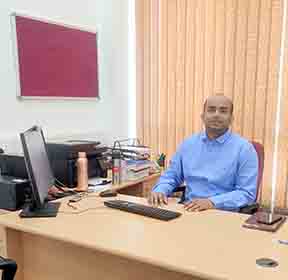Researchers at the Indian Institute of Technology Mandi and Durham University, United Kingdom have developed a testing setup to investigate the impact of climate change on railway embankments. This, in turn, would help mitigate climate risk at the design stage of railway embankments for a more sustainable construction, they say.
The findings of this study are published in the ASCE Journal of Geotechnical and Geoenvironmental Engineering, USA, published by the American Society of Civil Engineers.
The study was conducted by Dr. Ashutosh Kumar, Assistant Professor, School of Engineering, IIT Mandi, and co-authored by Dr. Arash Azizi, Assistant Professor, University of Portsmouth, UK and Prof. David Geoffrey Toll, Department of Engineering, Durham University, UK.
The main component of railway infrastructure is the track-bed, which is supported by earthworks. This is mainly used to support the track infrastructure and carry the load of the moving traffic.
The research is significant. The present design protocols only consider the load developed due to the moving train.
The design ignores natural state of the soil of embankments, which is changed by ingress and egress of water. Oftentimes, soil used in earthworks is compacted and remains unsaturated during its lifetime.
Extreme rainfalls and droughts are new villains of climate change
But extreme rainfalls and droughts are new villains of climate change on the railways track. There are seasonal variations in extreme rainfalls and drought. They alter amount of water present within this compacted soil mass, which can further alter the strength of the embankment.
Dr. Ashutosh Kumar, Assistant Professor, School of Engineering, IIT Mandi said the climate change is causing intense rainfall. "Compacted soil under railways tracks can deteriorate under the changing climatic conditions".
“This happens due to changes in the water holding capacity of the soil. It causes a hysteretic loss in the soil strength”. In addition, the repeated train movement on the track deteriorates process further. It would ultimately degrade the track prematurely and result in failure", he observed.
This study has developed a setup that include all kinds of factors involved in degradation process of railway embankments to address the entire problem, he said.
The researchers took samples from the 650-km heavy haul South African coal line for this study. "This line connects around 40 mines to the Richards Bay Coal Terminal in South Africa".
Dr. Kumar said the research is unique in its kind. “We would understand the combined impact of cyclic traffic-induced loading and environmental loading on the long-term performance of unsaturated soil present within the railway embankments”.
The setup uses a high-capacity tensiometer developed at Durham University. “It measures all kinds of changes taking place on the Railways embankments”.
“We have adopted three testing protocols and arrived at the results”. “The results indicate that deformation and reduction in soil strength are due to the combined impact of cyclic and environmental loading”, he said.
This suction monitoring setup can test the soil sample that has undergone the seasonal variation in both laboratory environment or field conditions.
“This would help to develop strategies to mitigate climate risk at the design stage of railway embankments”, researchers said. “Once design takes care of all possible weaknesses, we will have more sustainable construction of railway embankments or tracks”.





